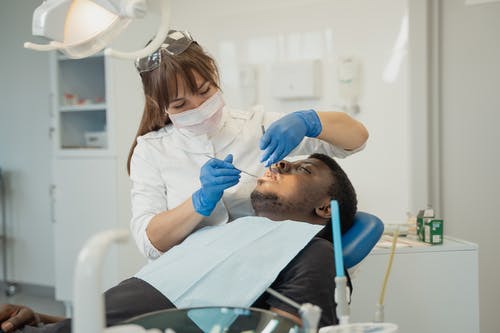Maintaining optimal oral health is crucial to your overall well-being. But when it comes to specific dental issues, many people may overlook early signs, often because they’re subtle or simply unfamiliar. One such procedure that can catch many by surprise is gum grafting. So, do you need a gum graft? Here are some signs to watch for, along with an understanding of the gum grafting procedure and how it can benefit your health.
Understanding Gum Recession
Gum recession happens when the tissue that surrounds your teeth wears away, or pulls back, exposing more of the tooth or its root. This can lead to the formation of gaps between teeth and gums, allowing disease-causing bacteria to build up. When left untreated, the supporting tissue and bone structures of the teeth can become severely damaged, eventually resulting in tooth loss.
Gum recession is a common dental problem, but many people don’t know they have it because it occurs gradually. The first sign of gum recession is often tooth sensitivity, or you may notice a tooth looks longer than normal. A notch can be felt near the gum line. It’s essential to regularly have dental check-ups, as a dentist can often spot signs of gum recession early even when you can’t.
Common Signs That You Need a Gum Graft
Sensitivity to Hot and Cold
One of the primary indicators that you might need a gum graft is heightened sensitivity in your teeth. If you feel a sharp pain when consuming hot drinks or icy treats, your nerves might be more exposed due to receding gums. This is because, under normal circumstances, your tooth’s roots are protected by both gum and bone, preventing sensitivity.
When gums recede, it can expose the base of the teeth, which is not covered by the hard enamel layer. This leads to discomfort when exposed to temperature variations. If you’re consistently dealing with this sensitivity, it might be time to consider seeing a dental professional who can assess whether gum recession is the root cause.
Noticeably Longer Teeth
If your teeth seem to be growing longer, that is often another clear sign of gum recession. As gums pull back, the tooth appears elongated due to the increased exposure of the root. This is not just a cosmetic concern; it indicates that the support system for the teeth is deteriorating.
Observing longer teeth should prompt you to check for other symptoms of gum recession. Paying attention to these signs is crucial because the longer gum disease is left untreated, the more devastating and invasive the treatment can become. Additionally, if you’re feeling self-conscious about your smile, a gum graft can aesthetically enhance it by recreating the fullness of healthy gums.
Frequent Gum Bleeding
Healthy gums generally do not bleed. If you notice bleeding while brushing or flossing regularly, it might be more than just a sign of rough handling; it could indicate gum disease. Bleeding gums are often one of the earliest signs of gum disease, like gingivitis, which can progress into more severe conditions if left untreated.
This bleeding occurs as your gums become inflamed and weakened, increasing the risk of recession. Catching this symptom early can help in taking preventative steps. While a gum graft might not be necessary for early gingivitis, progressive gum disease can make it inevitable. Therefore, proper oral hygiene and regular dental visits are key in managing this condition.
Swollen and Red Gums
Accompanying bleeding, swollen and red gums are also typical signs of inflammation. Healthy gums should be firm and pink. When gums become puffy and display a red hue, this indicates irritation and potential infection. The inflammation from this can cause further gum recession, making a gum graft potentially necessary to restore gum health and protect the teeth.
If you spot such symptoms, it’s advised to consult a dentist who might suggest treatments ranging from improved oral care routines to professional cleanings. Early intervention can prevent the need for more invasive procedures down the line.
The Role of Professional Diagnosis
You may be incredibly attuned to your body’s signals, but diagnosing gum issues can be quite complex. That’s where the expertise of a dental professional becomes indispensable. A dentist can assess the condition of your gums using tools and techniques that go beyond what you can do at home. They might perform a simple visual inspection or more in-depth procedures like probes to measure gum pocket depths.
Consulting with a dentist can offer peace of mind, whether you’re apprehensive about your gum condition or simply looking for preventative care advice. If issues are detected, professionals can propose a comprehensive treatment plan tailored to your specific needs. Should they suggest a gum graft, you can comfortably find out how this procedure will alleviate your symptoms and improve your oral health.
What Happens During a Gum Graft?
If your dentist recommends a gum graft, understanding what happens during the procedure can demystify the process and lessen any anxiety. Simply put, gum grafting is a surgical procedure aimed at covering an area of exposed tooth root, helping to stop further gum loss and protect the bone underneath.
The procedure generally involves taking tissue from one area, often the roof of your mouth, and transplanting it to the affected site. There are different types of gum grafts—each with specific applications and benefits, which your dentist will discuss based on your particular case. Going through this procedure vastly reduces sensitivity and protects against gum recession while bolstering the structural integrity of your teeth.
Find out more about the numerous benefits of undergoing a gum graft and how this seamless procedure can enhance your dental health.
Post-Procedure Care and Expectations
Post-procedure recovery plays a vital role in the success of a gum graft. Following your dentist’s care instructions is crucial during this time. Typically, a soft diet is recommended to ensure minimal trauma to the surgical site. Additionally, maintaining excellent oral hygiene without disturbing the graft is vital in preventing infections.
Over-the-counter pain relief may help manage discomfort, but your dentist will provide specific pain management and healing tips. While the idea of post-procedure healing might be daunting, remember the end goal—a healthy, secure smile that you can confidently show off without worry. Many have found relief from symptoms they simply accepted, like sensitivity or bleeding, by addressing their oral health with proactive measures.
Potential Causes of Gum Recession and How to Address Them
Understanding what causes gum recession can aid in mitigating its effects and preventing further dental complications. Aggressive brushing, genetic predisposition, and even grinding of teeth can contribute to gum recession. Habits like smoking or poor oral hygiene exacerbate these conditions, too.
If you have habits that may accelerate gum disease, it might be time to reconsider them. For instance, adopting a gentler brushing technique with a soft-bristle brush can make a world of difference. Additionally, if bruxism or teeth grinding is an issue, using a protective night guard can prevent damage not just to your teeth, but also provide relief from gum stress.
For those facing more severe issues such as fractured teeth in Palm Beach, FL could be beneficial before they lead to more substantial gum issues.
Gum Health and Total Wellness
Gum health is an integral component of overall wellness. Beyond aesthetics, a healthy set of gums is essential in preventing diseases such as periodontitis—a severe gum infection that damages the soft tissue and can destroy the bone that supports your teeth.
Maintaining robust gum health requires regular check-ups and practicing diligent oral hygiene. Small changes, like using floss and having professional cleanings, can ensure that your gums stay strong and fit. Understanding the signs you need a gum graft can not only safeguard your smile but also enhance your overall health, proving that preventative care is the cornerstone of lifelong wellness.
Your dental journey is unique, and staying informed about procedures like gum grafting can empower you to make the best health decisions. If you suspect any issues or experience changes in gum health, don’t hesitate to seek advice. Knowing when to seek a gum graft is only part of the battle; equally significant is adopting a holistic approach to dental care.
To learn more about both the symptoms and treatments available, and how you can address them with your dentist, keep navigating dental care resources that provide patient-focused insights. Your health’s best ally is information, and in the realm of dentistry, keeping your gums secure strongly supports your overall wellbeing.



